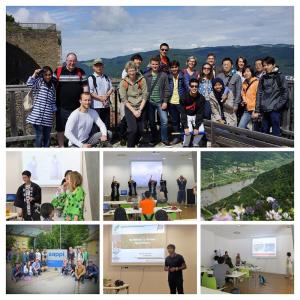Manufacturing and Value Creation Seminar I at BOKU, Austria
A joint retreat for students at the University of Natural Resources and Life Sciences, Vienna, (BOKU) and students of the Shinshu University Leading Program was held at BOKU in Austria over the 10-day period from June 17 to June 27 as Manufacturing and Value Creation Seminar I, which is a required course for first-year students in the Leading Program. It was the second time for the program to be held at BOKU in as many years, and two Japanese second- and fourth-year students joined the first-year students in participating.
As part of the seminar, students visited Sappi, a pulp and paper plant; Lenzing, a textile manufacturing plant; a paper museum; and the Center for International Relations (CIR) at BOKU's Vienna headquarters.
In addition to research presentations by both groups of students, workshops included group presentations designed to introduce the two groups' respective cultures as part of an effort to foster intercultural exchange. The Leading Program students focused on anime and kimono in their presentations. In the group presentation about kimono, the Japanese students helped the BOKU students put on yukata, and then both groups of students wore happi coats and performed a traditional Japanese dance, creating a feeling of togetherness.
The fact that some students began pursuing a plan for joint research with BOKU during the retreat attests to its effectiveness.
We would like to take this opportunity to offer our heartfelt thanks Professor Rosenau and secretary Christiane Gollner, who planned and organized the retreat, as well as the BOKU students who welcomed Leading Program students for their hospitality.
Student's report by Mr. Dennis Burger (1st-year student)
1. Purpose of participation
The purpose of the trip was to present our research in an atmosphere mimicking that of a conference. The audience consisted of students from Shinshu University and of PhD students from the BOKU University in Vienna. Further professors from BOKU and Shinshu University also took part in the discussion. After the presentations the audience could ask questions and was able to dig deeper into the research topic of the presenter. Other than that we also had two factory tours which gave us some impressions on the paper-making industry and the cellulose fiber industry.
The trip was also a great opportunity for us to form academic contacts and friendships that will surely make a difference in our future. As cooperations in the academic world often depend on contacts, this trip was a great chance for us to build up our network.
I also believe that the experience we get by travelling to a foreign country and by diving into a foreign culture contributes to our growth as a character. Thereby we are able to broaden our perspective and to increase our understanding of other people, not just raising us to become good researchers but giving us critical thinking capacity and enhancing our ability to make new contacts.
2. Issues identified as a result of participation
In general I hardly had any issues. Due to time restrictions prior to the trip I was not able to make as much experiments as I would have liked to, which is why I was also slightly limited with the data I could add to my research presentation.
3. Results of participation
By discussing with Prof. Rosenau I was able to get very interesting input for my research topic going as far as Prof. Rosenau wanting to contact my supervisor Prof. Tamada to talk about the possibility of joint research. It was very nice to have an audience that was interested in my topic and to discuss and explain more about my research.
I was also able to get into a lot of contact with the students from Prof. Rosenau's laboratory which was very nice and funny as they gave me the opportunity to get a local view on the Vienna lifestyle. I was able to get a lot of experience from this trip, cultural as well as scientific. The most astounding fact for me was probably that cotton is actually also made out of wood and not just out of the common cotton plant.
4. How will you apply what you learned to your research?
From the discussion after my presentation I was able to get some very interesting ideas on my research and other factors that I should sort out before presenting at a conference. This includes for instance the immunogenicity of the materials I use and the suitability for different tissues of the body. Further I would be happy to combine Prof. Rosenaus's research on cellulose fibers with my research about the application of the silk protein in tissue engineering.